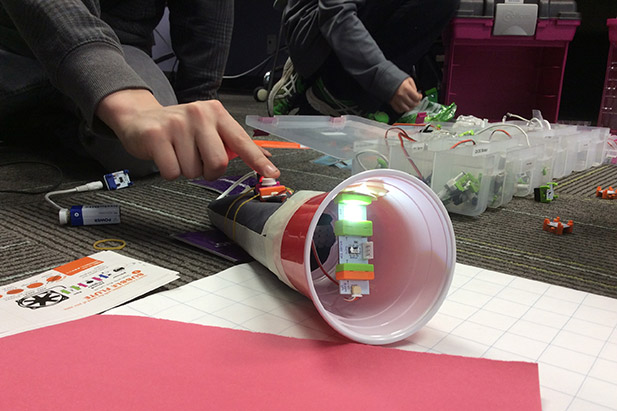March Break madness at UOIT’s Maker Camp
May 6, 2016

In a world where children are immersed in technology from a young age, many education experts today are pushing for the integration of computational skills into school curricula as a way of boosting digital literacy among youngsters. But there’s another parallel movement on the rise: the do-it-yourself maker culture, which combines art and design with traditional science and technology disciplines for a more holistic creative and inventive learning experience.
Researchers at the University of Ontario Institute of Technology (UOIT) recognize the value of blending science, technology, engineering, the arts and math (STEAM) as a way to foster creativity and innovation. The UOIT Faculty of Education's STEAM 3D Maker Lab's March Break Maker Camp gave 16 local youngsters in grades 4 to 8 a unique opportunity to tinker, build and create their own inventions using both digital and physical materials.
“The teaching methodologies and tools in the STEAM 3D Maker Lab promote inquiry, play, imagination and innovation – while helping children develop their design, critical-thinking, problem-solving and collaboration skills,” said Dr. Janette Hughes, Canada Research Chair in Technology and Pedagogy, who heads up the Lab. “I was pleased to see the students using the lab’s equipment to design, engineer and fabricate digitally-enhanced products of all kinds.”

The camp's daily sessions were divided into two blocks. In the morning students worked on math and art coding activities using Scratch, a free visual programming language. The morning sessions were sponsored by the Fields Institute for Research in Math Science and conducted in partnership with Dr. George Gadanidis at Western University. Afternoons focused on a different makerspace tool each day, incorporating both literacy and art, and were overseen by Dr. Hughes’ research team in the Lab.
Students created animations, games, LED-infused paper art and simple robots during the week. The camp concluded with a gallery walk for parents to see what their children had accomplished.
Learning tools included:
- PancakeBot and other 3D printers
- Chibitronics paper circuits
- LilyPad Arduinos - sewable electronic modules
- LittleBits - modular electronics that snap together with magnets
- MaKey MaKey invention kits
- Piktochart infographic design app
Parental feedback was overwhelmingly positive, with many saying their children already want to take part in future Faculty of Education Maker Lab camps.
Select participant testimonials:
- “I enjoyed everything! I liked coding and the MaKey MaKey; you could use things that had organic materials to make something move and control something.”
- “I could make anything I wanted, in any way I wanted”
- “I liked the paper circuits. All you have to do is push the paper and it all lights up. LittleBits was cool too; I loved the feeling of seeing the finished project working and realizing, ‘Oh my gosh, I did that and it’s so cool!’”
- “My favourite part of the camp was when we got to do the LittleBits where we can make an invention like a flashlight. I really like how you can make things that are found in the instruction book. I also like how you can make original things that aren’t in the instructions. I made a motion sensor!”



